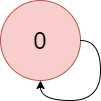Problem
There is a directed graph of n colored nodes and m edges. The nodes are numbered from 0 to n - 1.
You are given a string colors where colors[i] is a lowercase English letter representing the color of the ith node in this graph (0-indexed). You are also given a 2D array edges where edges[j] = [aj, bj] indicates that there is a directed edge from node aj to node bj.
A valid path in the graph is a sequence of nodes x1 -> x2 -> x3 -> ... -> xk such that there is a directed edge from xi to xi+1 for every 1 <= i < k. The color value of the path is the number of nodes that are colored the most frequently occurring color along that path.
Return **the *largest color value* of any valid path in the given graph, or -1 if the graph contains a cycle**.
Example 1:

Input: colors = "abaca", edges = [[0,1],[0,2],[2,3],[3,4]]
Output: 3
Explanation: The path 0 -> 2 -> 3 -> 4 contains 3 nodes that are colored "a" (red in the above image).
Example 2:

Input: colors = "a", edges = [[0,0]]
Output: -1
Explanation: There is a cycle from 0 to 0.
Constraints:
n == colors.lengthm == edges.length1 <= n <= 10^50 <= m <= 10^5colorsconsists of lowercase English letters.0 <= aj, bj < n
Solution
class Solution {
public int largestPathValue(String colors, int[][] edges) {
int len = colors.length();
List<Integer>[] graph = buildGraph(len, edges);
int[] frequencies = new int[26];
HashMap<Integer, int[]> calculatedFrequencies = new HashMap<>();
int[] status = new int[len];
for (int i = 0; i < len; i++) {
if (status[i] != 0) {
continue;
}
int[] localMax = runDFS(graph, i, calculatedFrequencies, status, colors);
if (localMax[26] == -1) {
Arrays.fill(frequencies, -1);
break;
} else {
for (int color = 0; color < 26; color++) {
frequencies[color] = Math.max(frequencies[color], localMax[color]);
}
}
}
int max = Integer.MIN_VALUE;
for (int freq : frequencies) {
max = Math.max(max, freq);
}
return max;
}
private int[] runDFS(
List<Integer>[] graph,
int node,
HashMap<Integer, int[]> calculatedFrequencies,
int[] status,
String colors) {
if (calculatedFrequencies.containsKey(node)) {
return calculatedFrequencies.get(node);
}
int[] frequencies = new int[27];
if (status[node] == 1) {
frequencies[26] = -1;
return frequencies;
}
status[node] = 1;
for (int neighbour : graph[node]) {
int[] localMax = runDFS(graph, neighbour, calculatedFrequencies, status, colors);
if (localMax[26] == -1) {
return localMax;
}
for (int i = 0; i < 26; i++) {
frequencies[i] = Math.max(frequencies[i], localMax[i]);
}
}
status[node] = 2;
int color = colors.charAt(node) - 'a';
frequencies[color]++;
calculatedFrequencies.put(node, frequencies);
return frequencies;
}
private List<Integer>[] buildGraph(int n, int[][] edges) {
List<Integer>[] graph = new ArrayList[n];
for (int i = 0; i < n; i++) {
graph[i] = new ArrayList<>();
}
for (int[] edge : edges) {
graph[edge[0]].add(edge[1]);
}
return graph;
}
}
Explain:
nope.
Complexity:
- Time complexity : O(n).
- Space complexity : O(n).